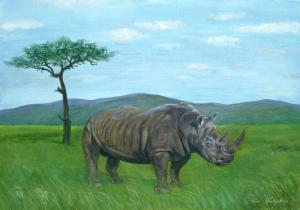Sale on canvas prints! Use code ABCXYZ at checkout for a special discount!

It is amazing that something so large can have such a profound impact on the smaller world around it, some of which is too small for us to see.
At up to 7,000 pounds, the White Rhinoceros helps shape grasslands by grazing through the plants they choose to eat. They adjust their eating habits according to the chemical changes within the plants, which in turn vary according to the rainy and dry seasons. As a result, these herbivores increase the diversity of plant life. Rhinoceros pave the way through dense brush for other animals and open up areas for different kinds of plants to grow. Their manure enriches the soil, germinates seeds, and supports insect and invertebrate communities. Through their digging, they provide the necessary pools of water for frogs and insects to breed.
While their horns are compositionally the same as our fingernails, they are prized for their "medicinal" properties in places around the world. As a result, the Northern White Rhinoceros subspecies has been all but wiped out by poaching. Habitat loss from farming and settlements is another challenge facing the rhinoceros.
Recently, program restructuring has provided an incentive to local communities to value these animals staying alive. For example, in the Hluhluwe-Umfolozi Reserve in South Africa, tourists pay a community levy that supports the local Zululand people. Local farmers now work in concert with the wildlife, which places less strain on the harvesting of natural grasses. It also encourages more sustainable farming of fruits and vegetables, which are sold to restaurants.
If you would like more information on what is being done to protect rhinoceros, visit the International Rhino Foundation, a nonprofit organization dedicated to conservation and research of the world's rhino species.